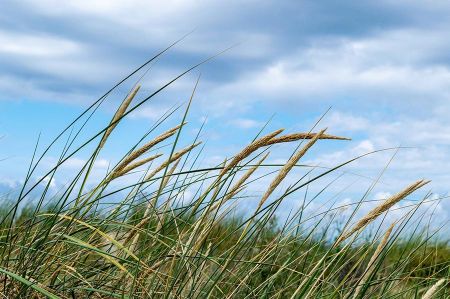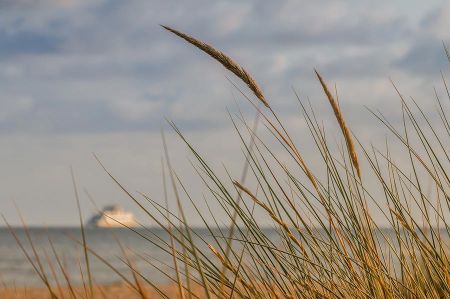Beach grass - a native plant of particular use
- Written by Portal Editor
The mudflat hike to the bird sanctuary island of Minsener Oog actually motivated us to write this article, because it was only this new perspective on the otherwise rather unknown plant that made the true importance of beach grass for coastal protection clear to us.
Oats have been cultivated as a food for centuries and beach grass has also been used as a grain for making bread throughout history, albeit not very effectively, but at times when there is no real alternative!
The common beach grass - important in coastal protection
 The special importance of the common beach grass today lies primarily in its ability to strengthen the seaward edge dunes of the islands and the mainland, and thus the beach grass serves to protect the coast from storm surges.
The special importance of the common beach grass today lies primarily in its ability to strengthen the seaward edge dunes of the islands and the mainland, and thus the beach grass serves to protect the coast from storm surges.
Due to this protective function, these dunes are also referred to as "protective dunes" according to the Lower Saxony Dyke Act and are even deliberately planted with beach grass, which is taken from intact and healthy stocks.
 In Central Europe, including many parts of northern Germany and the East Frisian Islands, in the Middle Ages, many inland dunes of Pleistocene origin that had been consolidated by plant growth became shifting dunes again due to overuse as pastureland.
In Central Europe, including many parts of northern Germany and the East Frisian Islands, in the Middle Ages, many inland dunes of Pleistocene origin that had been consolidated by plant growth became shifting dunes again due to overuse as pastureland.
This ultimately led to a loss of arable land and thus to the loss of settlement and cultivation areas.
In the 17th century, the first plantings of marram grass were therefore carried out inland. Most marram grass populations in sandy habitats can be traced back to this circumstance. The same applies to the East Frisian Islands such as Wangerooge, Langeoog and others.
 As the dune landscape with the marram grass used is particularly important for flood protection, it is clear that these areas should not be entered by holidaymakers and tourists. Protective dunes should only be entered on designated paths, as the impact of trampling not only affects the sensitive seedlings, but also tramples down the fully grown plants.
As the dune landscape with the marram grass used is particularly important for flood protection, it is clear that these areas should not be entered by holidaymakers and tourists. Protective dunes should only be entered on designated paths, as the impact of trampling not only affects the sensitive seedlings, but also tramples down the fully grown plants.
The wind can then blow the sand away unhindered, narrow channels can blow out into meter-deep ravines and ultimately set entire dunes in motion, which ultimately means that the protective function of the coast is lost.
Minsener Oog - an island artificially fortified with marram grass
 Of course, marram grass alone does not work miracles, but if used effectively, it can help to provide natural coastal protection. We were able to see for ourselves on Minsener Oog, because the deep root system of the marram grass is clearly visible, especially on the edges of the artificially washed-up land created by high tide and flooding. It forms roots up to 5 m deep and is therefore planted as a sand trap. Its dense root system effectively holds sand in place, so that even the constant coastal winds can hardly carry away any sand. Marram grass forms a so-called taproot, with which it anchors itself deep in the sand and absorbs groundwater. In addition, it also builds a network of finely branched roots and runners to the side. The root system of a plant can cover an area of around 25 m² (5x5 m)! It is clear that this knowledge is used by humans and that is why beach grass has been planted for decades to protect dunes and coasts. In the past, beach grass was also called "helmet" in the coastal region.
Of course, marram grass alone does not work miracles, but if used effectively, it can help to provide natural coastal protection. We were able to see for ourselves on Minsener Oog, because the deep root system of the marram grass is clearly visible, especially on the edges of the artificially washed-up land created by high tide and flooding. It forms roots up to 5 m deep and is therefore planted as a sand trap. Its dense root system effectively holds sand in place, so that even the constant coastal winds can hardly carry away any sand. Marram grass forms a so-called taproot, with which it anchors itself deep in the sand and absorbs groundwater. In addition, it also builds a network of finely branched roots and runners to the side. The root system of a plant can cover an area of around 25 m² (5x5 m)! It is clear that this knowledge is used by humans and that is why beach grass has been planted for decades to protect dunes and coasts. In the past, beach grass was also called "helmet" in the coastal region.
However, there are also disadvantages to beach grass.
 Once planted, the plant spreads almost everywhere on its own and is therefore considered an invasive neophyte, because in many places it is becoming an increasing problem due to its high spreading and competitive power, as it displaces the native flora and changes the existing ecosystems. For example, in Humboldt Bay (California), the common beach grass is now being targeted as part of a management plan.
Once planted, the plant spreads almost everywhere on its own and is therefore considered an invasive neophyte, because in many places it is becoming an increasing problem due to its high spreading and competitive power, as it displaces the native flora and changes the existing ecosystems. For example, in Humboldt Bay (California), the common beach grass is now being targeted as part of a management plan.
In conversation with the bird warden present at Minsener Oog, the real importance of marram grass became clear to us, because coastal protection with marram grass and the associated loss of sand also means that silting up of the shipping lanes is avoided, which ultimately makes marram grass an economic factor in transport.
 In earlier centuries, the tough leaves of the beach grass were used to make cords and ropes, known as ropes, and also to make mats. We find time and again that modern technology can help solve numerous problems, but looking at nature just as often means that there are already natural solutions to our modern problems that simply don't have to be produced cheaply on an industrial scale and then sold at a high price, making "our" economy even more lucrative and profit-oriented. Natural resources are usually neglected, as is a look into the future. After all, it's always just about making a quick profit.
In earlier centuries, the tough leaves of the beach grass were used to make cords and ropes, known as ropes, and also to make mats. We find time and again that modern technology can help solve numerous problems, but looking at nature just as often means that there are already natural solutions to our modern problems that simply don't have to be produced cheaply on an industrial scale and then sold at a high price, making "our" economy even more lucrative and profit-oriented. Natural resources are usually neglected, as is a look into the future. After all, it's always just about making a quick profit.
Please read as well:
Cosplay, manga, anime - at the Leipzig Book Fair
Early romantic park at the moated castle of Lütetsburg
